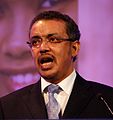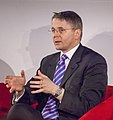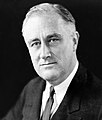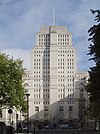University of London: Difference between revisions
→Sports, clubs and traditions: remove entries with no citations |
Rescuing 10 sources and tagging 0 as dead. #IABot (v1.6.1) (Feminist) |
||
| Line 105: | Line 105: | ||
[[File:Senate House, University of London.jpg|right|thumb|[[Senate House (University of London)|Senate House]], the headquarters of the University of London since 1937]] |
[[File:Senate House, University of London.jpg|right|thumb|[[Senate House (University of London)|Senate House]], the headquarters of the University of London since 1937]] |
||
The university owns a considerable [[central London]] estate 12 hectares freehold land in [[Bloomsbury]], near [[Russell Square tube station]].<ref>{{cite web| url=http://www.london.ac.uk/138.html|title=The Central University's Estate |
The university owns a considerable [[central London]] estate 12 hectares freehold land in [[Bloomsbury]], near [[Russell Square tube station]].<ref>{{cite web| url=http://www.london.ac.uk/138.html| title=The Central University's Estate| publisher=University of London| accessdate=2016-06-22| deadurl=yes| archiveurl=https://web.archive.org/web/20060213000715/http://www.london.ac.uk/138.html| archivedate=13 February 2006| df=dmy-all}}</ref> |
||
Some of the university's colleges have their main buildings on the estate. The Bloomsbury Campus also contains eight Halls of Residence and [[Senate House (University of London)|Senate House]], which houses [[Senate House Library]], the chancellor's official residence and previously housed the [[School of Slavonic and East European Studies]], now part of [[University College London]] (UCL) and housed in its own new building. Almost all of the [[School of Advanced Study]] is housed in Senate House and neighbouring Stewart House.<ref>{{cite web| url=http://w01.sascms.wf.ulcc.ac.uk/348.html|title=Redevelopment Project of Senate House and Stewart House |
Some of the university's colleges have their main buildings on the estate. The Bloomsbury Campus also contains eight Halls of Residence and [[Senate House (University of London)|Senate House]], which houses [[Senate House Library]], the chancellor's official residence and previously housed the [[School of Slavonic and East European Studies]], now part of [[University College London]] (UCL) and housed in its own new building. Almost all of the [[School of Advanced Study]] is housed in Senate House and neighbouring Stewart House.<ref>{{cite web| url=http://w01.sascms.wf.ulcc.ac.uk/348.html| title=Redevelopment Project of Senate House and Stewart House| publisher=University of London School of Advanced Study| accessdate=2007-03-02| deadurl=yes| archiveurl=https://web.archive.org/web/20070928031207/http://w01.sascms.wf.ulcc.ac.uk/348.html| archivedate=28 September 2007| df=dmy-all}}</ref> |
||
The university also owns many of the squares that formed part of the Bedford Estate, including [[Gordon Square]], [[Tavistock Square]], [[Torrington Square]] and [[Woburn Square]], as well as several properties outside Bloomsbury, with many of the university's colleges and institutes occupying their own estates across London: |
The university also owns many of the squares that formed part of the Bedford Estate, including [[Gordon Square]], [[Tavistock Square]], [[Torrington Square]] and [[Woburn Square]], as well as several properties outside Bloomsbury, with many of the university's colleges and institutes occupying their own estates across London: |
||
| Line 306: | Line 306: | ||
* University College Nottingham, awarded a Royal Charter in 1948 as the [[University of Nottingham]]. |
* University College Nottingham, awarded a Royal Charter in 1948 as the [[University of Nottingham]]. |
||
* Hartley University College, Southampton, awarded a Royal Charter in 1952 as the [[University of Southampton]]. |
* Hartley University College, Southampton, awarded a Royal Charter in 1952 as the [[University of Southampton]]. |
||
* University College Hull, awarded a Royal Charter in 1954 as the [[University of Hull]].<ref>{{cite web|title=University History|url=http://www2.hull.ac.uk/theuniversity/history.aspx|website=University of Hull|accessdate=2014-12-17}}</ref> |
* University College Hull, awarded a Royal Charter in 1954 as the [[University of Hull]].<ref>{{cite web|title=University History|url=http://www2.hull.ac.uk/theuniversity/history.aspx|website=University of Hull|accessdate=2014-12-17|deadurl=yes|archiveurl=https://web.archive.org/web/20150107013059/http://www2.hull.ac.uk/theuniversity/history.aspx|archivedate=7 January 2015|df=dmy-all}}</ref> |
||
* University College of the South West of England, Exeter, awarded a Royal Charter in 1955 as the [[University of Exeter]]. |
* University College of the South West of England, Exeter, awarded a Royal Charter in 1955 as the [[University of Exeter]]. |
||
* University College Leicester, awarded a Royal Charter in 1957 as the [[University of Leicester]]. |
* University College Leicester, awarded a Royal Charter in 1957 as the [[University of Leicester]]. |
||
| Line 330: | Line 330: | ||
Some of the colleges which were in special relation are listed below, along with the year in which their special relation was established. |
Some of the colleges which were in special relation are listed below, along with the year in which their special relation was established. |
||
* 1946 – The University College of the West Indies, until 1961. (Now the [[University of the West Indies]])<ref>{{cite web|url=http://www.uwi.edu/aboutuwi/briefhistory.aspx |title=University of the West Indies |publisher=Uwi.edu |date=24 June 1986 |accessdate=2010-04-13}}</ref> |
* 1946 – The University College of the West Indies, until 1961. (Now the [[University of the West Indies]])<ref>{{cite web |url=http://www.uwi.edu/aboutuwi/briefhistory.aspx |title=University of the West Indies |publisher=Uwi.edu |date=24 June 1986 |accessdate=2010-04-13 |deadurl=yes |archiveurl=https://web.archive.org/web/20100527093104/http://www.uwi.edu/aboutuwi/briefhistory.aspx |archivedate=27 May 2010 |df=dmy-all }}</ref> |
||
* 1948 – University College, Ibadan, until 1967. (Now the [[University of Ibadan]])<ref>{{cite web|url=http://www.ui.edu.ng/deptmedicine.htm |title=Archived copy |accessdate=2006-11-11 |deadurl=bot: unknown |archiveurl=https://web.archive.org/web/20061009145219/http://www.ui.edu.ng/deptmedicine.htm |archivedate=9 October 2006 |df= }}</ref> |
* 1948 – University College, Ibadan, until 1967. (Now the [[University of Ibadan]])<ref>{{cite web|url=http://www.ui.edu.ng/deptmedicine.htm |title=Archived copy |accessdate=2006-11-11 |deadurl=bot: unknown |archiveurl=https://web.archive.org/web/20061009145219/http://www.ui.edu.ng/deptmedicine.htm |archivedate=9 October 2006 |df= }}</ref> |
||
* 1956 – University College of Rhodesia and Nyasaland (now the [[University of Zimbabwe]]). |
* 1956 – University College of Rhodesia and Nyasaland (now the [[University of Zimbabwe]]). |
||
| Line 357: | Line 357: | ||
In {{HESA year}}, {{HESA student population|INSTID=LON}} students (approximately 5% of all UK students) attended one of the University of London's [[federated school|affiliated schools]].<ref name="HESA citation"/> Additionally, over 50,000 students follow the [[University of London International Programmes]].<ref name="External"/> |
In {{HESA year}}, {{HESA student population|INSTID=LON}} students (approximately 5% of all UK students) attended one of the University of London's [[federated school|affiliated schools]].<ref name="HESA citation"/> Additionally, over 50,000 students follow the [[University of London International Programmes]].<ref name="External"/> |
||
The ULU building on [[Malet Street]] (close to Senate House) was home to the [[University of London Union]], which acted as the [[Students' union|student union]] for all University of London students alongside the individual college and institution unions. The building is now rebranded as 'Student Central, London', offering full membership to current University of London students, and associate membership to students at other universities, and other groups. The union previously owned ''[[London Student]],'' the largest student newspaper in Europe, which now runs as a digital news organisation<ref>{{cite web|author=BAM Agency Ltd |url=http://www.ulu.co.uk/content/index.php?page=9 |title=London Student |publisher=Ulu.co.uk |date= |accessdate=2010-04-13}}</ref><ref>{{cite web|title=About London Student: A workers’ co-operative student media startup|url=http://www.lsnews.co.uk/team/|website=[[London Student]]|accessdate=2015-07-15}}</ref> |
The ULU building on [[Malet Street]] (close to Senate House) was home to the [[University of London Union]], which acted as the [[Students' union|student union]] for all University of London students alongside the individual college and institution unions. The building is now rebranded as 'Student Central, London', offering full membership to current University of London students, and associate membership to students at other universities, and other groups. The union previously owned ''[[London Student]],'' the largest student newspaper in Europe, which now runs as a digital news organisation<ref>{{cite web|author=BAM Agency Ltd |url=http://www.ulu.co.uk/content/index.php?page=9 |title=London Student |publisher=Ulu.co.uk |date= |accessdate=2010-04-13}}</ref><ref>{{cite web|title=About London Student: A workers’ co-operative student media startup|url=http://www.lsnews.co.uk/team/|website=[[London Student]]|accessdate=2015-07-15|deadurl=yes|archiveurl=https://web.archive.org/web/20150716014001/http://www.lsnews.co.uk/team/|archivedate=16 July 2015|df=dmy-all}}</ref> |
||
===Sports, clubs and traditions=== |
===Sports, clubs and traditions=== |
||
| Line 373: | Line 373: | ||
The university operates the following eight intercollegiate [[halls of residence]], which accommodate students from most of its colleges and institutions:<ref>{{cite web|url=http://www.lon.ac.uk/halls.html |title=University of London – Intercollegiate Halls |publisher=Lon.ac.uk |date=26 March 2010 |accessdate=2010-04-13}}</ref> |
The university operates the following eight intercollegiate [[halls of residence]], which accommodate students from most of its colleges and institutions:<ref>{{cite web|url=http://www.lon.ac.uk/halls.html |title=University of London – Intercollegiate Halls |publisher=Lon.ac.uk |date=26 March 2010 |accessdate=2010-04-13}}</ref> |
||
* [[College Hall, London|College Hall]], [[Malet Street]], WC1<ref>{{cite web|url=http://www.halls.london.ac.uk/student/college/Default.aspx |title=University of London Accommodation – College Hall |publisher=Halls.london.ac.uk |date= |accessdate=2010-04-13}}</ref> |
* [[College Hall, London|College Hall]], [[Malet Street]], WC1<ref>{{cite web |url=http://www.halls.london.ac.uk/student/college/Default.aspx |title=University of London Accommodation – College Hall |publisher=Halls.london.ac.uk |date= |accessdate=2010-04-13 |deadurl=yes |archiveurl=https://web.archive.org/web/20100408033201/http://www.halls.london.ac.uk/student/college/Default.aspx |archivedate=8 April 2010 |df=dmy-all }}</ref> |
||
* [[Connaught Hall, London|Connaught Hall]], [[Tavistock Square]], WC1<ref>{{cite web|url=http://www.halls.london.ac.uk/student/connaught/Default.aspx |title=University of London Accommodation – Connaught Hall |publisher=Halls.london.ac.uk |date= |accessdate=2010-04-13}}</ref> |
* [[Connaught Hall, London|Connaught Hall]], [[Tavistock Square]], WC1<ref>{{cite web |url=http://www.halls.london.ac.uk/student/connaught/Default.aspx |title=University of London Accommodation – Connaught Hall |publisher=Halls.london.ac.uk |date= |accessdate=2010-04-13 |deadurl=yes |archiveurl=https://web.archive.org/web/20100317121943/http://www.halls.london.ac.uk/student/connaught/Default.aspx |archivedate=17 March 2010 |df=dmy-all }}</ref> |
||
* [[International Hall, London|International Hall]], [[Brunswick Square]], WC1<ref>{{cite web|url=http://www.halls.london.ac.uk/student/international/Default.aspx |title=University of London Accommodation – International Hall |publisher=Halls.london.ac.uk |date= |accessdate=2010-04-13}}</ref> |
* [[International Hall, London|International Hall]], [[Brunswick Square]], WC1<ref>{{cite web |url=http://www.halls.london.ac.uk/student/international/Default.aspx |title=University of London Accommodation – International Hall |publisher=Halls.london.ac.uk |date= |accessdate=2010-04-13 |deadurl=yes |archiveurl=https://web.archive.org/web/20100412123643/http://www.halls.london.ac.uk/student/international/Default.aspx |archivedate=12 April 2010 |df=dmy-all }}</ref> |
||
* Lillian Penson Hall, Talbot Square, W2<ref>{{cite web|url=http://www.halls.london.ac.uk/student/lillianpenson/Default.aspx |title=University of London Accommodation – Lillian Penson Hall |publisher=Halls.london.ac.uk |date= |accessdate=2010-04-13}}</ref> |
* Lillian Penson Hall, Talbot Square, W2<ref>{{cite web |url=http://www.halls.london.ac.uk/student/lillianpenson/Default.aspx |title=University of London Accommodation – Lillian Penson Hall |publisher=Halls.london.ac.uk |date= |accessdate=2010-04-13 |deadurl=yes |archiveurl=https://web.archive.org/web/20100418020656/http://www.halls.london.ac.uk/student/lillianpenson/Default.aspx |archivedate=18 April 2010 |df=dmy-all }}</ref> |
||
* [[Nutford House, London|Nutford House]], Brown Street, W1<ref>{{cite web|url=http://www.halls.london.ac.uk/student/nutford/Default.aspx |title=University of London Accommodation – Nutford House |publisher=Halls.london.ac.uk |date= |accessdate=2010-04-13}}</ref> |
* [[Nutford House, London|Nutford House]], Brown Street, W1<ref>{{cite web |url=http://www.halls.london.ac.uk/student/nutford/Default.aspx |title=University of London Accommodation – Nutford House |publisher=Halls.london.ac.uk |date= |accessdate=2010-04-13 |deadurl=yes |archiveurl=https://web.archive.org/web/20100327074021/http://www.halls.london.ac.uk/student/nutford/Default.aspx |archivedate=27 March 2010 |df=dmy-all }}</ref> |
||
'''The Garden Halls''' |
'''The Garden Halls''' |
||
Revision as of 23:23, 22 December 2017
| File:University of London.svg University of London Coat of Arms | ||||||||||||
| Latin: Universitas Londiniensis | ||||||||||||
| Type | Public | |||||||||||
|---|---|---|---|---|---|---|---|---|---|---|---|---|
| Established | 1836 | |||||||||||
| Chancellor | The Princess Royal | |||||||||||
| Vice-Chancellor | Sir Adrian Smith[1] | |||||||||||
| Visitor | The Lord President of the Council ex officio | |||||||||||
| Students | 213,270 (161,270 internal[2] and 52,000 International Programmes)[3] | |||||||||||
| Undergraduates | 92,760 internal (2019/20)[2] | |||||||||||
| Postgraduates | 68,500 internal (2019/20)[2] | |||||||||||
| Location | London , England, United Kingdom 51°31′16″N 0°07′44″W / 51.52111°N 0.12889°W | |||||||||||
| Deputy Vice Chancellor | Edward Byrne[4] | |||||||||||
| Chair of the Board of Trustees | Sir Richard Dearlove[5] | |||||||||||
| Colours | ||||||||||||
| Website | london.ac.uk | |||||||||||
The University of London is a collegiate[a] and a federal research university located in London, England. The University was incorporated originally by royal charter in 1836 and is, at present, incorporated by royal charter granted in 1863.[6] It is now governed by the University of London Act 1994[7] and by the Statutes made under it.[7] The university currently consists of 18 constituent colleges, nine research institutes and a number of central bodies.[8] The collegiate university houses the second-oldest medical school in London[9], and was the first to admit women[10] as degree candidates in the United Kingdom and also the first to appoint a female as its Vice Chancellor in the United Kingdom.
The university is the largest university by number of full-time students in the United Kingdom, with 161,270 campus-based students and over 50,000 distance learning students in the University of London International Programmes. The university was established by royal charter in 1836, as a degree-awarding examination board for students holding certificates from University College London and King's College London and "other such other Institutions, corporate or unincorporated, as shall be established for the purpose of Education, whether within the Metropolis or elsewhere within our United Kingdom".[11] The university moved to a federal structure in 1900.[12]
Most constituent colleges rank in the top 50 universities in the United Kingdom and for most practical purposes, ranging from admissions to funding, the constituent colleges operate on an independent basis, with some recently obtaining the power to award their own degrees whilst remaining in the federal university. The ten largest colleges of the university are University College London, King's College London, Queen Mary, City, Birkbeck, the London School of Economics and Political Science, Royal Holloway, Goldsmiths, SOAS, and St George's. The specialist colleges of the university include the London Business School, the Royal Veterinary College and Heythrop College, specialising in philosophy and theology. Imperial College London was formerly a member, before leaving the university a century later in 2007.[13] City is the most recent constituent college, having joined on 1 September 2016.[14]
As on 2015, there are a total of around 2 million[15] University of London alumni across the world, which include 12 monarchs or royalty, 52 presidents or prime ministers, 84 Nobel laureates, 6 Grammy winners, 2 Oscar winners and 3 Olympic gold medalists. The collegiate research university has also produced Father of the Nation for several countries.[b]
In post-nominals, the University of London is commonly abbreviated as Lond. or, more rarely, Londin., from the Latin Universitas Londiniensis, after its degree abbreviations.
History
19th century
University College London (University College London) was founded under the name “London University” in 1826 as a secular alternative to the religious universities of Oxford and Cambridge.[16] In response to the theological controversy surrounding such educational establishment, King's College London (KCL) was founded and was the first to be granted a royal charter (in 1829).[17][18]
Yet to receive a royal charter, UCL in 1834 renewed its application for a royal charter as a university (originally applied for in 1830), which would grant it the power to confer degrees.[19] In response to this, opposition to "exclusive" rights grew among the London medical schools. The idea of a general degree awarding body for the schools was discussed in the medical press.[20] and in evidence taken by the Select Committee on Medical Education.[21][22] However, the blocking of a bill to open up Oxford and Cambridge degrees to dissenters led to renewed pressure on the Government to grant degree awarding powers to an institution that would not apply religious tests,[23][24][25] particularly as the degrees of the new University of Durham were also to be closed to non-Anglicans.[26]
In 1835, the government announced the response to UCL's petition for a charter. Two charters would be issued, one to UCL incorporating it as a college rather than a university, without degree awarding powers, and a second "establishing a Metropolitan University, with power to grant academical degrees to those who should study at the London University College, or at any similar institution which his Majesty might please hereafter to name".[27]
Following the issuing of its charter on 28 November 1836, the university started drawing up regulations for degrees in March 1837. The death of William IV in June, however, resulted in a problem – the charter had been granted "during our Royal will and pleasure", meaning it was annulled by the king's death.[28] Queen Victoria issued a second charter on 5 December 1837, reincorporating the university. The university awarded its first degrees in 1839, all to students from UCL and King's College.
The university established by the charters of 1836 and 1837 was essentially an examining board with the right to award degrees in arts, laws and medicine. However, the university did not have the authority to grant degrees in theology, considered the senior faculty in the other three English universities. In medicine, the university was given the right to determine which medical schools provided sufficient medical training. In arts and law, by contrast, it would examine students from UCL, King's College, or any other school or college granted a royal warrant, effectively giving the government control of which colleges could affiliate to the university. Beyond the right to submit students for examination, there was no other connection between the affiliated colleges and the university.
In 1849 the university held its first graduation ceremony at Somerset House following a petition to the senate from the graduates, who had previously received their degrees without any ceremony. About 250 students graduated at this ceremony. The London academic robes of this period were distinguished by their "rich velvet facings".[29]
The list of affiliated colleges grew by 1858 to include over 50 institutions, including all other British universities. In that year, a new charter effectively abolished the affiliated colleges system by opening up the examinations to everyone whether they attended an affiliated college or not.[30] This led the Earl of Kimberley, a member of the university's senate, to tell the House of Lords in 1888 "that there were no Colleges affiliated to the University of London, though there were some many years ago".[31] The reforms of 1858 also incorporated the graduates of the university into a convocation, similar to those of Oxford, Cambridge and Durham, and authorised the granting of degrees in science, the first BSc being awarded in 1860.[32]
The expanded role meant the university needed more space, particularly with the growing number of students at the provincial university colleges. Between 1867 and 1870 a new headquarters was built at 6 Burlington Gardens, providing the university with exam halls and offices.
In 1863, via a fourth charter, the university gained the right to grant degrees in surgery.[33] This 1863 charter remains the authority under which the university is incorporated, although all its other provisions were abolished under the 1898 University of London Act.
In 1878, the university set another first when it became the first university in the UK to admit women to degrees, via the grant of a supplemental charter. Four female students obtained Bachelor of Arts degrees in 1880 and two obtained Bachelor of Science degrees in 1881, again the first in the country.[34]
In the late 19th century, the university came under criticism for merely serving as a centre for the administration of tests, and there were calls for a "teaching university" for London. UCL and KCL considered separating from the university to form a separate university, variously known as the Albert University, Gresham University and Westminster University. Following two royal commissions the University of London Act 1898 was passed, reforming the university and giving it a federal structure with responsibility for monitoring course content and academic standards within its institutions. This was implemented in 1900 with the approval of new statutes for the university.[35]
-
Somerset House in 1836. The university had its offices here from 1837 to 1870.
-
King William IV, who granted the University of London its original royal charter in 1836.
-
An illustration of 6 Burlington Gardens, home to the university administration from 1870 to 1900.
20th century
The reforms initiated by the 1898 act came into force with the approval of the new federal statutes in 1900. Many of the colleges in London became schools of the university, including UCL, King's College, Bedford College, Royal Holloway and the London School of Economics. Regent's Park College, which had affiliated in 1841, became an official divinity school of the university in 1901 (the new statutes having given London the right to award degrees in theology); Goldsmiths College joined in 1904; Imperial College was founded in 1907; Queen Mary College joined in 1915; the School of Oriental and African Studies was founded in 1916; and Birkbeck College, which was founded in 1823, joined in 1920.
The previous provision for colleges outside London was not abandoned on federation, instead London offered two routes to degrees: "internal" degrees offered by schools of the university and "external" degrees offered at other colleges (now the University of London International Programmes).
UCL and King's College, whose campaign for a teaching university in London had resulted in the university's reconstitution as a federal institution, went even further than becoming schools of the university and were actually merged into it. UCL's merger, under the 1905 University College London (Transfer) Act, happened in 1907. The charter of 1836 was surrendered and all of UCL's property became the University of London's. King's College followed in 1910 under the 1908 King's College London (Transfer) Act. This was a slightly more complicated case, as the theological department of the college (founded in 1846) did not merge into the university but maintained a separate legal existence under King's College's 1829 charter.[36]
The expansion of the university's role meant that the Burlington Garden premises were insufficient, and in March 1900 it moved to the Impetial Institute in South Kensington.[37] However, its continued rapid expansion meant that it had outgrown its new premises by the 1920s, requiring yet another move. A large parcel of land in Bloomsbury near the British Museum was acquired from the Duke of Bedford and Charles Holden was appointed architect with the instruction to create a building "not to suggest a passing fashion inappropriate to buildings which will house an institution of so permanent a character as a University." This unusual remit may have been inspired by the fact that William Beveridge, having just become director of LSE, upon asking a taxi driver to take him to the University of London was met with the response "Oh, you mean the place near the Royal School of Needlework".[38] Holden responded by designing Senate House, the current headquarters of the university, and at the time of completion the second largest building in London.[39]
During the Second World War, the colleges of the university (with the exception of Birkbeck) and their students left London for safer parts of the UK, while Senate House was used by the Ministry of Information, with its roof becoming an observation point for the Royal Observer Corps. Though the building was hit by bombs several times, it emerged from the war largely unscathed; rumour at the time had it that the reason the building had fared so well was that Adolf Hitler had planned to use it as his headquarters in London.[40]
The latter half of the last century was less eventful. In 1948, Athlone Press was founded as the publishing house for the university, and sold to the Bemrose Corporation in 1979,[41] subsequent to which it was acquired by Continuum publishing.[42] However, the post-WWII period was mostly characterised by expansion and consolidation within the university, such as the acquisition as a constituent body of the Jesuit theological institution Heythrop College on its move from Oxfordshire in 1969.
The 1978 University of London Act saw the university defined as a federation of self-governing colleges, starting the process of decentralisation that would lead to a marked transference of academic and financial power in this period from the central authorities in Senate House to the individual colleges. In the same period, UCL and King's College regained their legal independence via acts of parliament and the issuing of new royal charters. UCL was reincorporate in 1977, while King's College's new charter in 1980 reunited the main body of the college with the corporation formed in 1829. One of the largest shifts in power of this period came in 1993, when HEFCE switched from funding the University of London, which then allocated money to the colleges, to funding the colleges directly and them paying a contribution to the University.[35]
There was also a tendency in the late 20th century for smaller colleges to be amalgamated into larger "super-colleges". Some of the larger colleges (most notably UCL, King's College, LSE and Imperial) periodically put forward the possibility of their departure from the university, although no steps were taken to actually putting this into action until the early 21st century.

21st century
In 2002, Imperial College and UCL mooted the possibility of a merger, raising the question of the future of the University of London and the smaller colleges within it. Subsequently, considerable opposition from academic staff of both UCL and Imperial led to a rejection of the merger.[43]
Despite this failure, the trend of decentralising power continued. A significant development in this process was the closing down of the Convocation of all the university's alumni in October 2003; this recognised that individual college alumni associations were now increasingly the centre of focus for alumni.[44] However, the university continued to grow even as it moved to a looser federation, and, in 2005, admitted the Central School of Speech and Drama.
On 9 December 2005, Imperial College became the second constituent body (after Regent's Park College) to make a formal decision to leave the university. Its council announced that it was beginning negotiations to withdraw from the university in time for its own centenary celebrations, and in order to be able to award its own degrees. On 5 October 2006, the University of London accepted Imperial's formal request to withdraw from it.[45] Imperial became fully independent on 9 July 2007, as part of the celebrations of the college's centenary.
The Times Higher Education Supplement announced in February 2007 that the London School of Economics, University College London and King's College London all planned to start awarding their own degrees, rather than degrees from the federal University of London as they had done previously, from the start of the academic year starting in Autumn 2007. Although this plan to award their own degrees did not amount to a decision to leave the University of London, the THES suggested that this "rais[ed] new doubts about the future of the federal University of London".[citation needed]
The School of Pharmacy, University of London, merged with UCL on 1 January 2012, becoming the UCL School of Pharmacy within the Faculty of Life Sciences.[46] This was followed on 2 December 2014 by the Institute of Education also merging with UCL, becoming the UCL Institute of Education.[47]
Since 2010, the university has been outsourcing support services such as cleaning and portering. This has prompted industrial action by the largely Latin American workforce under the "3Cosas" campaign (the 3Cosas – 3 causes –being sick pay, holiday pay, and pensions for outsourced workers on parity with staff employed directly by the university). The 3Cosas campaigners were members of the UNISON trade union. However, documents leaked in 2014 revealed that UNISON representatives tried to counter the 3Cosas campaign in meetings with university management.[48] The 3Cosas workers subsequently transferred to the Independent Workers Union of Great Britain.
Following good results in the Research Excellence Framework in December 2014, City University London said that they were exploring the possibility of joining the University of London.[49] It was subsequently announced in July 2015 that City would join the University of London in August 2016.[14] It will cease to be an independent university and become a college as "City, University of London".[50]
Campuses
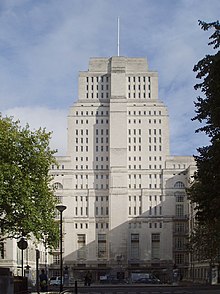
The university owns a considerable central London estate 12 hectares freehold land in Bloomsbury, near Russell Square tube station.[51]
Some of the university's colleges have their main buildings on the estate. The Bloomsbury Campus also contains eight Halls of Residence and Senate House, which houses Senate House Library, the chancellor's official residence and previously housed the School of Slavonic and East European Studies, now part of University College London (UCL) and housed in its own new building. Almost all of the School of Advanced Study is housed in Senate House and neighbouring Stewart House.[52]
The university also owns many of the squares that formed part of the Bedford Estate, including Gordon Square, Tavistock Square, Torrington Square and Woburn Square, as well as several properties outside Bloomsbury, with many of the university's colleges and institutes occupying their own estates across London:
- Clare Market,
- The Aldwych, where the London School of Economics and Political Science and part of King's College London are based
- The North and East Wings of Somerset House, the location for the Courtauld Institute of Art and King's College London, respectively
- St Bartholomew's Hospital,
- the University of London Boat Club in Chiswick, and
- the Egham campus of Royal Holloway with its historic Founder's Building.
The university also has several properties outside London, including a number of residential and catering units further afield and the premises of the University of London Institute in Paris, which offers undergraduate and postgraduate degrees in French and historical studies.
Organisation and administration
The ten largest institutions of the federal university, usually termed the colleges, are Birkbeck, Goldsmiths, King's College London, the London Business School, Queen Mary, Royal Holloway, SOAS, City, LSE and UCL. Formerly a constituent college, Imperial College London left the University of London in 2007.
For most practical purposes, ranging from admission of students to negotiating funding from the government, the 18 constituent colleges are treated as individual universities. Legally speaking they are known as Recognised Bodies, with the authority to examine students and award them degrees of the university. Some colleges have the power to award their own degrees instead of those of the university; those which exercise that power include:
- Royal Holloway, University of London
- SOAS, University of London
- City, University of London
- Goldsmiths, University of London
- St George's, University of London
- Queen Mary University of London
- King's College London
- University College London
- London School of Economics and Political Science
Most decisions affecting the constituent colleges and institutions of the University of London are made at the level of the colleges or institutions themselves. The University of London does retain its own decision-making structure, however, with the Collegiate Council and Board of Trustees, responsible for matters of academic policy. The Collegiate Council is made up of the Heads of Colleges of the university.[53]
The 12 institutes, or Listed Bodies, within the University of London offer courses leading to degrees that are both examined and awarded by the University of London. Additionally, twelve universities in England, several in Canada and many in other Commonwealth countries (notably in East Africa) began life as associate colleges of the university offering such degrees. By the 1970s, almost all of these colleges had achieved independence from the University of London. An increasing number of overseas and UK-based academic institutes offer courses to support students registered for the University of London International Programmes's diplomas and degrees and the Teaching Institutions Recognition Framework enables the recognition of these institutions.
Colleges
The current constituent colleges of the University of London are as follows:
Central academic bodies
- University of London International Programmes
- University of London Institute in Paris, formerly known as the British Institute in Paris
- School of Advanced Study comprising the following institutes:
- the Institute of Advanced Legal Studies
- the Institute of Classical Studies
- the Institute of Commonwealth Studies
- the Institute of English Studies
- the Institute of Historical Research
- the Institute of Latin American Studies
- the Institute of Modern Languages Research
- the Institute of Philosophy
- the Warburg Institute
Former colleges and schools
Some colleges and schools of the University of London have been amalgamated into larger colleges or left the University of London. These include:
Imperial College London – became independent in July 2007[54]
- Wye College – Wye, Kent; Wye courses are now run by the University of Kent in partnership with Imperial College London, and graduating students receive a University of Kent degree and an Imperial Associateship of Wye College[55]
- Royal Postgraduate Medical School; now part of the Imperial College School of Medicine
Royal Holloway, University of London
- Bedford College – Inner Circle Regent's Park; now part of Royal Holloway and Bedford New College (the legal title of Royal Holloway, University of London, under its establishing act of parliament)
- Institute of Musical Research - moved from School of Advanced Study in 2015
- Chelsea College – Manresa Road, Chelsea; now part of King's College London
- Queen Elizabeth College – Campden Hill Road, Kensington; now part of King's College London
- Institute of Psychiatry – split from Maudsley Hospital, merged with King's College London in 1997
- United Medical and Dental Schools of Guy's and St Thomas' Hospitals – merged with King's College London in 1998, now part of King's College School of Medicine and Dentistry
- The School of Pharmacy, University of London; merged with University College London on 1 January 2012
- School of Slavonic and East European Studies although formerly an Institute of the University of London, rather than a college, is now part of University College London
- Institute of Education; merged with University College London on 2 December 2014
Queen Mary, University of London
- Westfield College – Kidderpore Avenue, Hampstead; now part of Queen Mary and Westfield College (the registered Royal Charter title of Queen Mary, University of London)
Others
- The Lister Institute of Preventive Medicine, Chelsea, London, founded 1891. In 1978 became a science funding body
- New College London, was closed in 1980. Despite the name the college never had any association with Royal Holloway and Bedford New College.
- Regent's Park College moved to Oxford in 1927, becoming a Permanent Private Hall of the University of Oxford from 1957
- University Marine Biological Station, Millport, closed in 2013, now run by Field Studies Council
University colleges in the external degree programme
A number of major universities originated as university colleges teaching the degrees of (what is now) the International Programmes.
- Mason College, Birmingham, awarded a Royal Charter in 1900 as the University of Birmingham.
- Owen's College Manchester, became part of the Victoria University in 1880, awarded a Royal Charter in 1903 as the Victoria University of Manchester.
- University College Liverpool, became part of the Victoria University in 1884, awarded a Royal Charter in 1903 as the University of Liverpool.
- Yorkshire College, Leeds, became part of the Victoria University in 1887, awarded a Royal Charter in 1904 as the University of Leeds.
- Firth College, Sheffield, awarded a Royal Charter in 1905 as the University of Sheffield.
- Bristol University College, awarded a Royal Charter in 1909 as the University of Bristol.
- University College Reading, awarded a Royal Charter in 1926 as the University of Reading.
- Ceylon University College, established by the Ceylon University Ordinance Act in 1942 as the University of Ceylon.
- University College Nottingham, awarded a Royal Charter in 1948 as the University of Nottingham.
- Hartley University College, Southampton, awarded a Royal Charter in 1952 as the University of Southampton.
- University College Hull, awarded a Royal Charter in 1954 as the University of Hull.[56]
- University College of the South West of England, Exeter, awarded a Royal Charter in 1955 as the University of Exeter.
- University College Leicester, awarded a Royal Charter in 1957 as the University of Leicester.
- University College of South Wales and Monmouthshire, Cardiff, joined the University of Wales in 1893 and became Cardiff University in 2005.
- University College of Wales, Aberystwyth, joined the University of Wales in 1893 and became Aberystwyth University in 2007.
- University College of North Wales, Bangor, joined the University of Wales in 1893 and became Bangor University in 2007.
A number of other colleges had degrees validated and awarded by the University of London.[57]
- St. Patrick's, Carlow College, Ireland – from 1840 to 1892 students studied for primary degrees in Arts (BA) and Law (BLL).[58]
- St. Patrick's College, Thurles, Ireland – from 1849 the University of London, allowed Thurles to offer degrees.[59]
- Huddersfield College
- Queen's College, Birmingham[60]
- Stonyhurst College, a Catholic college in Lancashire.
- Wesleyan Collegiate Institution, Taunton, which became Queen's College, Taunton.
- Ceylon Technical College, 1933 – 1950 students studied for engineering degrees in BSc in Engineering.
- University College Lahore
- Singapore Institute of Management
- Northwest College for Advanced Learning, India
Colleges in special relation
Between 1946 and 1970, the university entered into 'schemes of special relation' with university colleges in the Commonwealth of Nations. These schemes encouraged the development of independent universities by offering a relationship with the University of London. University colleges in these countries were granted a Royal Charter. An Academic Board of the university college negotiated with the University of London over the entrance requirements for the admission of students, syllabuses, examination procedures and other academic matters. During the period of the special relationship, graduates of the colleges were awarded University of London degrees.
Some of the colleges which were in special relation are listed below, along with the year in which their special relation was established.
- 1946 – The University College of the West Indies, until 1961. (Now the University of the West Indies)[61]
- 1948 – University College, Ibadan, until 1967. (Now the University of Ibadan)[62]
- 1956 – University College of Rhodesia and Nyasaland (now the University of Zimbabwe).
- 1961 – Royal College Nairobi (now the University of Nairobi).
- 1963 – University of East Africa
In 1970, the 'Schemes of Special Relation' were phased out.
Coat of arms
The University of London first received a grant of arms in April 1838.[63] The arms depict a cross of St George upon which there is a Tudor rose surrounded by detailing and surmounted by a crown. Above all of this there is a blue field with an open book upon it.
The arms are described in the grant as:
- Argent, the Cross of St George, thereon the Union Rose irradiated and ensigned with the Imperial Crown proper, a Chief Azure, thereon an open Book also proper, Clasps gold[63]
Academic dress
The University of London had established a rudimentary code for academic dress by 1844. The university was the first to devise a system of academic dress based on faculty colours, an innovation that was subsequently followed by most other universities.
Since their being granted autonomous degree awarding powers, King's College London, The London School of Economics and Political Science and University College London have each introduced their own form of academic dress. Queen Mary, University of London, as of 2014, introduced its own form of academic dress to reflect its autonomous degree awarding powers.[64] The remaining colleges of the university continue to use the University of London academic dress.
Student life

In 2019/20, students (approximately 5% of all UK students) attended one of the University of London's affiliated schools.[2] Additionally, over 50,000 students follow the University of London International Programmes.[3]
The ULU building on Malet Street (close to Senate House) was home to the University of London Union, which acted as the student union for all University of London students alongside the individual college and institution unions. The building is now rebranded as 'Student Central, London', offering full membership to current University of London students, and associate membership to students at other universities, and other groups. The union previously owned London Student, the largest student newspaper in Europe, which now runs as a digital news organisation[65][66]
Sports, clubs and traditions
Though most sports teams are organised at the college level, ULU ran a number of sports clubs of its own, some of which (for example the rowing team) compete in BUCS leagues. The union also organised its own leagues for college teams to participate in. These leagues and sports clubs are supported by Friends of University of London Sport which aims to promote them.
In addition to these, ULU catered for sports not covered by the individual colleges through clubs such as the University of London Union Lifesaving Club, which helps students gain awards and learn new skills in lifesaving as well as sending teams to compete throughout the country in the BULSCA league.
ULU also organised a number of societies, ranging from Ballroom and Latin American Dance to Shaolin Kung Fu, and from the University of London Big Band to the Breakdancing Society. Affiliated to the university is the University of London Society of Change Ringers, a society for bellringers at all London universities.
The university runs the University of London Boat Club.
Student housing

The university operates the following eight intercollegiate halls of residence, which accommodate students from most of its colleges and institutions:[67]
- College Hall, Malet Street, WC1[68]
- Connaught Hall, Tavistock Square, WC1[69]
- International Hall, Brunswick Square, WC1[70]
- Lillian Penson Hall, Talbot Square, W2[71]
- Nutford House, Brown Street, W1[72]
The Garden Halls
- Canterbury Hall, Cartwright Gardens, WC1[73]
- Commonwealth Hall, Cartwright Gardens, WC1[73] (paired with Hughes-Parry Hall for administration)
- Hughes Parry Hall, Cartwright Gardens, WC1[73] (paired with Canterbury Hall for administration)
Notable people
Notable alumni, faculty and staff
-
Mahatma Gandhi, Father of the Nation for India
-
Nelson Mandela, Father of the Nation for South Africa
-
Tedros Adhanom, 8th Director-General of the World Health Organization
-
V. K. Krishna Menon, 3rd Defence Minister of India
-
Fred Mulley, Former British Secretary of State for Defence
-
Elton John, English singer and composer.
-
Mick Jagger, English singer and composer.
A large number of famous individuals have passed through the University of London, either as staff or students, including at least 12 monarchs or royalty, 52 presidents or prime ministers, 84 Nobel laureates, 6 Grammy winners, 2 Oscar winners, 1 Ekushey Padak winner and 3 Olympic gold medalists. The collegiate research university has also produced Father of the Nation for several countries.
Staff and students of the university, past and present, have contributed to a number of important scientific advances, including the discovery of vaccines by Edward Jenner and Henry Gray (author of Gray's Anatomy). Additional vital progress was made by University of London people in the following fields: the discovery of the structure of DNA (Francis Crick, Maurice Wilkins and Rosalind Franklin); the invention of modern electronic computers (Tommy Flowers); the discovery of penicillin (Alexander Fleming and Ernest Chain); the development of X-Ray technology (William Henry Bragg and Charles Glover Barkla); discoveries on the mechanism of action of Interleukin 10 (Anne O'Garra); the formulation of the theory of electromagnetism (James Clerk Maxwell); the determination of the speed of light (Louis Essen); the development of antiseptics (Joseph Lister); the development of fibre optics (Charles K. Kao); and the invention of the telephone (Alexander Graham Bell).
Notable political figures who have passed through the university include Muhammad Haji Ibrahim Egal, Romano Prodi, Junichiro Koizumi, Aung San Suu Kyi, Ramsay MacDonald, Desmond Tutu, Taro Aso, Walter Rodney, Nelson Mandela, John F. Kennedy, Dr. B. R. Ambedkar and Mahatma Gandhi.
In the arts, culture and literature the university has produced many notable figures. Writers include novelists Malcolm Bradbury, G. K. Chesterton, H. G. Wells, Thomas Hardy, Arthur C. Clarke and J.G. Ballard. Artists associated with the university include Jonathan Myles-Lea, and several of the leading figures in the Young British Artists movement (including Ian Davenport, Tracey Emin and Damien Hirst). Outstanding musicians across a wide range include the conductor Sir Simon Rattle, the soprano Felicity Lott and both members of Gilbert and Sullivan, to Mick Jagger, Elton John, Dido, Pakistani singer Nazia Hassan (known in South Asia as the "Queen of Pop"), and Hong Kong singer Karen Mok, and members of the bands Coldplay, Keane, Suede, The Velvet Underground, Blur, Iron Maiden, Placebo, The Libertines, and Queen.
The university has also played host to film directors (Christopher Nolan, Derek Jarman), philosophers (Karl Popper, Roger Scruton), explorers (David Livingstone), international academics (Sam Karunaratne), Riccarton High School Head of Commerce, Tom Neumann and leading businessmen (Michael Cowpland, George Soros).
Honorary Alumni
The University of London presented its first honorary degrees in June 1903.[74][75] This accolade has been bestowed on a wide range of distinguished individuals from both the academic and non-academic worlds.[75] Honorary degrees are approved by the Collegiate Council, part of the University’s governance structure.[75]
-
René Cassin (1969), Recipient of Nobel Peace Prize in 1968
Chancellors
The Chancellors of the University of London since its founding are as follows:
- William Cavendish, 2nd Earl of Burlington, 1836–1856
- Granville Leveson-Gower, 2nd Earl Granville, 1856–1891
- Edward Stanley, 15th Earl of Derby, 1891–1893
- Farrer Herschell, 1st Baron Herschell, 1893–1899
- John Wodehouse, 1st Earl of Kimberley, 1899–1902
- Archibald Primrose, 5th Earl of Rosebery, 1902–1929
- William Lygon, 7th Earl Beauchamp, 1929–1931
- Alexander Cambridge, 1st Earl of Athlone, 1932–1955
- Queen Elizabeth The Queen Mother, 1955–1981
- Princess Anne (The Princess Royal from 1987), 1981–present
Vice-chancellors
Literature and popular culture
This section needs expansion. You can help by adding to it. (September 2017) |
When the University of New Zealand was constituted in 1874[76], it was a federal university modelled on the University of London, functioning principally as an examining body.[76] University of the Cape of Good Hope, when it was constituted in 1875 and authorised to be responsible for examinations throughout South Africa.[76] In Canada, similar structures were adopted, but on a regional basis.[76] The University of Toronto acted as an examining and degree awarding body for the province of Ontario from 1853 to 1887, by utilising an operating model based on that of University of London.[76]
Literature
Dr. Watson, a fictional character in the Sherlock Holmes stories by Sir Arthur Conan Doyle, received his medical degree from Barts and The London School of Medicine and Dentistry (now QMUL).
Films and others
The Senate House, London and constituent colleges of the University of London has been featured in Hollywood and British films. Jay Sean was a medical candidate[77][78] at the university, before dropping out to become British singer and songwriter.[79]
See also
- Golden triangle (universities)
- List of modern universities in Europe (1801–1945)
- Third-oldest university in England debate
- United Hospitals
References
- ^ "UOL Vice-Chancellor - Professor Sir Adrian Smith". University of London. Retrieved 8 September 2017.
- ^ a b c d Combined total of "Where do HE students study?". Higher Education Statistics Agency. Retrieved 1 March 2020. The listed institutions in the total are Birkbeck, Central School of Speech and Drama, City, University of London, Courtauld Institute of Art, Goldsmiths, Institute of Cancer Research, Institute of Education, King's College, Business School, School of Economics, School of Hygiene and Tropical Medicine, Queen Mary, Royal Academy of Music, Royal Holloway, Royal Veterinary College, School of Oriental and African Studies, St George's, Central institutes & activities and Heythrop College.
- ^ a b "Financial Statements 2014-15" (PDF). University of London. p. 7. Retrieved 9 September 2016.
- ^ "UOL - Professor Ed Byrne AC". University of London. Retrieved 8 September 2017.
- ^ "UOL - Sir Richard Dearlove KCMG OBE". University of London. Retrieved 8 September 2017.
- ^ "Governance of the University of London". University of London. Retrieved 22 September 2017.
- ^ a b "University of London Act 1994". Legislation.gov.uk. Retrieved 22 September 2017.
- ^ "About us". University of London. 22 June 2016. Retrieved 22 June 2016.
- ^ "The spooky secrets of London's oldest medical school". Times Higher Education. Retrieved 5 November 2017.
- ^ "The spooky secrets of London's oldest medical school". University of London International Programmes. Retrieved 5 November 2017.
- ^ University of London (1912). University of London, the Historical Record: (1836-1912) Being a Supplement to the Calendar, Completed to September 1912. First Issue. University of London Press. p. 26. Retrieved 13 January 2017.
- ^ University of London (1912). University of London, the Historical Record: (1836-1912) Being a Supplement to the Calendar, Completed to September 1912. First Issue. University of London Press. p. 7. Retrieved 13 January 2017.
- ^ "Imperial College splits from University of London". The Guardian. 5 October 2006. Retrieved 27 November 2015.
- ^ a b c Grove, Jack (16 July 2015). "City University London to join University of London". Times Higher Education. Retrieved 16 July 2015.
- ^ "UOL - Alumni and Friends". University of London. Retrieved 28 June 2017.
- ^ "History". University College London. Retrieved 22 April 2011.
- ^ Cockburn, King, McDonnell (1969), pp. 345–359
- ^ "Foundation". King's College London. Retrieved 9 February 2013.
- ^ University of London. Address from the Senate to the Council in support of the application of the University for a charter. 1834.
- ^ "Proposed University in London". London Medical Gazette. 13: 836–839. 1834.
- ^ "Select Committee on Medical Education". Parliamentary Papers, House of Commons and Command, Part 2. HMSO. 1834. p. 113.
- ^ "Select Committee on Medical Education". Selection of Reports and Papers of the House of Commons: Medical ; [2], Volume 36. 1836. p. 111.
- ^ "ADMISSION TO THE UNIVERSITIES. (Hansard, 1 August 1834)". hansard.millbanksystems.com. Retrieved 13 January 2017.
- ^ "LONDON UNIVERSITY. (Hansard, 26 March 1835)". hansard.millbanksystems.com. Retrieved 13 January 2017.
- ^ "The Oxford and Cambridge Admissions Controversy of 1834 on JSTOR". jstor.org. Retrieved 13 January 2017.
- ^ "DURHAM UNIVERSITY. (Hansard, 27 June 1832)". hansard.millbanksystems.com. Retrieved 13 January 2017.
- ^ "LONDON UNIVERSITY. (Hansard, 30 July 1835)". hansard.millbanksystems.com. Retrieved 13 January 2017.
- ^ Huber, V.A.; Newman, F.W. (1843). The English Universities: From the German. Vol. 3. William Pickering. p. 565. Retrieved 13 January 2017.
- ^ "University of London". Morning Chronicle. 11 May 1849. Retrieved 14 December 2015 – via British Newspaper Archive.
{{cite news}}: Unknown parameter|subscription=ignored (|url-access=suggested) (help) - ^ University of London (1912). University of London, the Historical Record: (1836-1912) Being a Supplement to the Calendar, Completed to September 1912. First Issue. University of London Press. p. 39. Retrieved 13 January 2017.
- ^ "CONSIDERATION OF COMMONS' AMENDMENTS. (Hansard, 11 August 1888)". hansard.millbanksystems.com. Retrieved 13 January 2017.
- ^ Francis Michael Glenn Willson (2004). The University of London, 1858–1900: The Politics of Senate and Convocation. Boydell Press. p. 5.
- ^ University of London (1912). University of London, the Historical Record: (1836-1912) Being a Supplement to the Calendar, Completed to September 1912. First Issue. University of London Press. p. 12. Retrieved 13 January 2017.
- ^ "University of London: Brief history". London.ac.uk. Retrieved 13 April 2010.
- ^ a b Grant, Malcolm (March 2005), The future of the University of London: a discussion paper from the Provost of UCL (PDF), pp. 3–6
- ^ University of London, the Historical Record: (1836–1912). University of London. 1912. pp. 7–24.
- ^ Willson, F.M.G. (2004). The University of London, 1858-1900: The Politics of Senate and Convocation. Boydell Press. p. 8. ISBN 9781843830658. Retrieved 13 January 2017.
- ^ "City of Sound". City of Sound. 22 November 2003. Retrieved 13 April 2010.
- ^ Emporis GmbH. "Emporis Buildings". Emporis.com. Retrieved 13 April 2010.
- ^ "Senate House, Bloomsbury, WC1 — The Twentieth Century Society". c20society.org.uk.
- ^ Archives in London & the M25 area (AIM25) (29 November 2006), "Athlone Press: 1945–1979", holdings at Senate House Library, University of London, retrieved 21 December 2009
{{citation}}: CS1 maint: numeric names: authors list (link) - ^ allbusiness (29 November 2006), "Sturrock departs Continuum", Article citing companies encompassed by Continuum, retrieved 21 December 2009
{{citation}}:|author=has generic name (help) - ^ The Guardian. 18 November 2002 Opposition ends Imperial and UCL merger dream
- ^ "University of London: Convocation". london.ac.uk. Retrieved 13 January 2017.
- ^ CBLAIR. "News_5-10-2006-13-17-17". imperial.ac.uk.
- ^ School of Pharmacy merges with UCL. Ucl.ac.uk (1 January 2012). Retrieved 2013-07-17.
- ^ "UCL and the Institute of Education confirm merger". ucl.ac.uk. Retrieved 13 January 2017.
- ^ The Guardian, https://www.theguardian.com/education/2014/mar/24/cost-private-contracts-universities-documents-services-workers
- ^ "Universities worry about fallout from research ranking | Education | The Guardian". theguardian.com. Retrieved 13 January 2017.
- ^ http://democracy.cityoflondon.gov.uk/documents/s53556/150723%2520City%2520University%2520London.pdf
- ^ "The Central University's Estate". University of London. Archived from the original on 13 February 2006. Retrieved 22 June 2016.
{{cite web}}: Unknown parameter|deadurl=ignored (|url-status=suggested) (help) - ^ "Redevelopment Project of Senate House and Stewart House". University of London School of Advanced Study. Archived from the original on 28 September 2007. Retrieved 2 March 2007.
{{cite web}}: Unknown parameter|deadurl=ignored (|url-status=suggested) (help) - ^ "University of London: Council membership" (PDF). Archived from the original (PDF) on 29 August 2006. Retrieved 24 October 2006.
- ^ "University of London News: Imperial College Leaves University of London". Archived from the original on 22 May 2011. Retrieved 4 December 2007.
{{cite web}}: Unknown parameter|deadurl=ignored (|url-status=suggested) (help) - ^ "Wye college". Archived from the original on 13 June 2007. Retrieved 5 March 2007.
{{cite web}}: Unknown parameter|deadurl=ignored (|url-status=suggested) (help) - ^ "University History". University of Hull. Archived from the original on 7 January 2015. Retrieved 17 December 2014.
{{cite web}}: Unknown parameter|deadurl=ignored (|url-status=suggested) (help) - ^ N. B. Harte, The University of London, 1836–1986
- ^ Carlow College Report Archived 23 July 2011 at the Wayback Machine HETAC
- ^ University of London – The Illustrated London News, 11 May 1850
- ^ A History of Birmingham, Chris Upton, 1993, ISBN 0-85033-870-0
- ^ "University of the West Indies". Uwi.edu. 24 June 1986. Archived from the original on 27 May 2010. Retrieved 13 April 2010.
{{cite web}}: Unknown parameter|deadurl=ignored (|url-status=suggested) (help) - ^ "Archived copy". Archived from the original on 9 October 2006. Retrieved 11 November 2006.
{{cite web}}: Unknown parameter|deadurl=ignored (|url-status=suggested) (help)CS1 maint: archived copy as title (link) - ^ a b Harte, N. B. (1986). The University of London, 1836–1986: An Illustrated History. Bloomsbury. p. 90. ISBN 978-0-485-12052-3. Retrieved 4 August 2015.
- ^ http://www.arcs.qmul.ac.uk/students/graduation/your-degree-award/index.html
- ^ BAM Agency Ltd. "London Student". Ulu.co.uk. Retrieved 13 April 2010.
- ^ "About London Student: A workers' co-operative student media startup". London Student. Archived from the original on 16 July 2015. Retrieved 15 July 2015.
{{cite web}}: Unknown parameter|deadurl=ignored (|url-status=suggested) (help) - ^ "University of London – Intercollegiate Halls". Lon.ac.uk. 26 March 2010. Retrieved 13 April 2010.
- ^ "University of London Accommodation – College Hall". Halls.london.ac.uk. Archived from the original on 8 April 2010. Retrieved 13 April 2010.
{{cite web}}: Unknown parameter|deadurl=ignored (|url-status=suggested) (help) - ^ "University of London Accommodation – Connaught Hall". Halls.london.ac.uk. Archived from the original on 17 March 2010. Retrieved 13 April 2010.
{{cite web}}: Unknown parameter|deadurl=ignored (|url-status=suggested) (help) - ^ "University of London Accommodation – International Hall". Halls.london.ac.uk. Archived from the original on 12 April 2010. Retrieved 13 April 2010.
{{cite web}}: Unknown parameter|deadurl=ignored (|url-status=suggested) (help) - ^ "University of London Accommodation – Lillian Penson Hall". Halls.london.ac.uk. Archived from the original on 18 April 2010. Retrieved 13 April 2010.
{{cite web}}: Unknown parameter|deadurl=ignored (|url-status=suggested) (help) - ^ "University of London Accommodation – Nutford House". Halls.london.ac.uk. Archived from the original on 27 March 2010. Retrieved 13 April 2010.
{{cite web}}: Unknown parameter|deadurl=ignored (|url-status=suggested) (help) - ^ a b c "University of London Accommodation – Garden Halls". Halls.london.ac.uk. Archived from the original on 10 April 2010. Retrieved 13 April 2010.
{{cite web}}: Unknown parameter|deadurl=ignored (|url-status=suggested) (help) - ^ Negley Harte, University of London (1968). University of London: An Illustrated History: 1836-1986. Athlone Press Ltd. Retrieved 17 September 2017.
- ^ a b c "Foundation Day - University of London". University of London. Retrieved 25 May 2017.
- ^ a b c d e Schreuder, Deryck M. Universities for a New World: Making a Global Network in International Higher Education, 1913-2013. SAGE Publications India, 2013. ISBN 9788132117780.
- ^ "10 Celebrities Who Went to Medical School". QS World University Rankings. Retrieved 5 November 2017.
- ^ "Jay Sean: From Medical Student To R&B Superstar". NPR. Retrieved 5 November 2017.
- ^ Nadeska Alexis (3 December 2009). "Jay Sean Says He's a 'More Serious' Beatboxer Than Justin Timberlake". The BoomBox. Retrieved 3 December 2009.
Notes
- ^ All students from all constituent colleges, central bodies and Institutes are members of their respective institutions and are also University of London students and alumnus. The University of London has a Collegiate Council which advises the Board of Trustees on the strategic direction of the University, and is responsible for ensuring the proper discharge of its academic affairs. It is chaired by the Vice-Chancellor, and its membership comprises the Deputy Vice-Chancellor (who is the Deputy Chair), all the Heads of the Colleges, the Dean and Chief Executive of the School of Advanced Study, and the Chief Executive of the University of London International Programmes.
- ^ The constituent colleges and central bodies of the University of London has graduated several "Father of the Nation or Founders" for several countries. Names include Mahatma Gandhi, Nelson Mandela, Muhammad Ali Jinnah, Lee Kuan Yew, Seewoosagur Ramgoolam, Jomo Kenyatta, Kwame Nkrumah.
- ^ Muhammad Ali Jinnah graduated from Inns of Court School of Law, which is now City Law School. In year 2016, City University London (CUL) "later renamed to City, University of London" became self-governing and one of the constituent college of the University of London.
Further reading
- Harte, Negley (2000). University of London: An Illustrated History: 1836–1986. London: A&C Black. ISBN 9780567564498.
- Thompson, F. M. L. (1990). The University of London and the World of Learning, 1836–1986. London: A&C Black. ISBN 9781852850326.
- Willson, F. M. G. (1995). Our Minerva: The Men and Politics of the University of London, 1836–58. London: Athlone Press. ISBN 9780485114799.
- Willson, F. M. G. (2004). The University of London, 1858–1900: The Politics of Senate and Convocation. London: Boydell Press. ISBN 9781843830658.




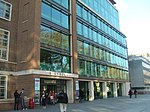
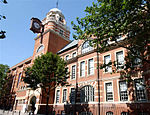
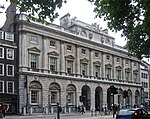
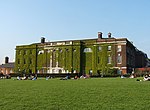










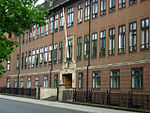


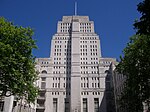



![Muhammad Ali Jinnah, Father of the Nation for Pakistan[c]](http://upload.wikimedia.org/wikipedia/en/thumb/1/14/Quaidportrait.jpg/90px-Quaidportrait.jpg)
